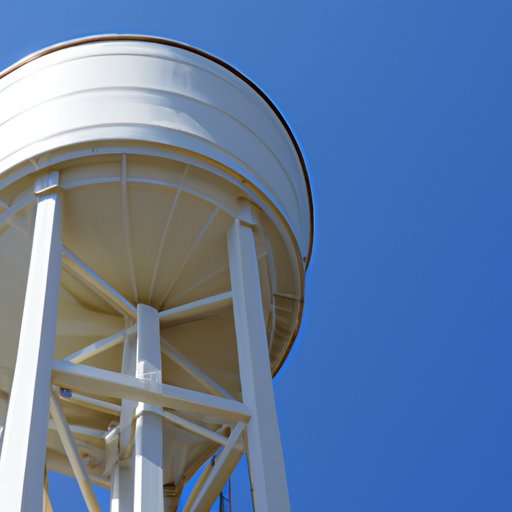Introduction
A water tower is an essential part of many water systems. It’s a large tank that stores water at a higher elevation than the rest of the system, allowing it to maintain a consistent pressure throughout the system. Water towers are used in many cities and towns around the world, providing a reliable supply of clean drinking water to millions of people every day.

Types of Water Towers and Their Advantages
Water towers come in a variety of shapes and sizes, and can be either ground-level or elevated. Ground-level reservoirs are typically large, open concrete or plastic tanks that store water at ground level. They are often located near the source of the water, such as a river or lake, and are used to regulate the flow of water into the system.
Elevated tanks are tall, cylindrical tanks that are mounted on towers. They are typically made of steel, concrete, or plastic, and can hold thousands of gallons of water. Elevated tanks are usually located in areas with high population density, such as cities, where they can provide a steady supply of water to the surrounding area.
Standpipes are smaller, vertical tanks that are designed to be placed on top of buildings. They are typically used in areas with limited space, such as apartment complexes or small towns. Standpipes can provide additional water storage capacity without taking up too much space.
Each type of water tower has its own advantages and disadvantages. Ground-level reservoirs are often less expensive to build and maintain than elevated tanks, but they require more land to install. Elevated tanks are more visible and are able to store more water, but are more expensive and require more maintenance. Standpipes are easy to install, but may not be able to provide enough water storage for larger populations.

How Water Towers are Built and Maintained
The location of a water tower is an important factor in determining its effectiveness. The tower must be built in an area that is easily accessible and has adequate room for the structure. In addition, the ground must be able to support the weight of the tower. Once the location is selected, the construction process can begin.
Building a water tower requires a combination of engineering, construction, and plumbing skills. The foundation of the tower must be able to support the weight of the tank, while the walls must be strong enough to contain the pressure of the water inside. The plumbing must be correctly installed to ensure that the water is delivered to the appropriate locations. Finally, the tower must be painted and sealed to protect it from the elements.
Once the tower is built, it must be regularly inspected and maintained. This includes checking for corrosion or damage, cleaning the interior and exterior, and performing necessary repairs. Regular maintenance helps to ensure that the tower is functioning properly and is able to provide a safe and reliable supply of water.
Benefits of Water Towers to Communities
Water towers provide a number of benefits to communities. One of the most notable is improved water pressure. By storing water at a higher elevation, the pressure within the system is increased, which in turn increases the flow rate of the water. This makes it easier to access water from faucets and showers, and also allows for more efficient irrigation of crops and gardens.
Water towers also allow for an increased water supply during peak hours. During times of high demand, such as in the morning when people are getting ready for work or school, the stored water can be released to meet the increased demand. This prevents water shortages and ensures that everyone has access to a sufficient amount of water.
Finally, water towers help to reduce energy consumption. When water is stored at a higher elevation, the pressure within the system is increased, which reduces the need for pumps to move the water. This means that less energy is needed to deliver the same amount of water, resulting in lower energy costs.
Conclusion
Water towers are an essential part of many water systems. They come in a variety of shapes and sizes, and can be built at ground level or elevated. The construction of a water tower requires a combination of engineering, construction, and plumbing skills, and must be regularly inspected and maintained. Water towers provide a number of benefits to communities, including improved water pressure, increased water supply during peak hours, and reduced energy consumption.
(Note: Is this article not meeting your expectations? Do you have knowledge or insights to share? Unlock new opportunities and expand your reach by joining our authors team. Click Registration to join us and share your expertise with our readers.)
